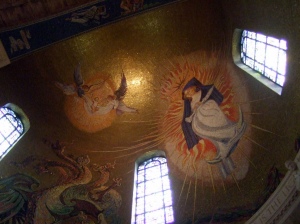It is sometimes claimed by Protestants that the identification of the Woman of the Apocalypse as Mary is a Medieval invention (I’ve heard the 12th century mentioned). But this just isn’t true.
In the Apocalypse of the apostle John it is written that the dragon stood in full view of the woman about to give birth, in order that when she gave birth, he would eat the child born [of her]. Let none of you ignore [the fact] that the dragon is the devil; know that the virgin signifies Mary, the chaste one, who gave birth to our chaste head. She also embodied in herself a figure of the holy church: namely, how, while bearing a son, she remained a virgin, so that the church throughout time bears her members, yet she does not lose her virginity.
Quodvultdeus of Carthage, Third Homily On the Creed, circa 440 AD
Who is this guy? He was a disciple and correspondent of St. Augustine’s who became bishop of nearby Carthage four years after Augustine’s death. This interpretation of the Woman of the Apocalypse is present in the very earliest days of the Augustinian tradition.


I think what they would point to is that one commentator does not determine an actual tradition. Those you have heard gesture that it was a later invention are noting that it was not the normal understanding of early commentators on the text until much later. As Jaroslav Pelikan notes, “Like the familiar parallel between Mary and Eve, most of these titles were based on a typological interpretation of the Old Testament in relation to Mary, but Mary, in turn, was seen as a type of the church. Therefore ‘the mariological interpretation’ of the vision of ‘a woman clothed with the sun’ in the Apocalypse, ‘which we take for granted, occurs only as an exception in the commentaries of the early Middle Ages,’ since the passage was usually applied to the church. This and other titles could sometimes be taken as ‘referring specifically to her, although generally to the church.'” – “The Growth of Medieval Theology 600-1300”, page 70, and he’s quoting and drawing on here Ambrose’s commentary on the Apocalypse, the Paschasius Radbertus Exposition on Matthew, and Wilheim Kamlah “Apokalypse und Geschichtheologie: Die mitterlaterliche Auslegung der Apocalypse vor Joachim von Fiore.”
I have no problem with someone pointing out that this interpretation occurred infrequently among the Fathers and only developed into a major theme in the Middle Ages. My problem is specifically with implying that it didn’t exist in the Patristic period.
And, by the way, I don’t have scholarly writings in mind.